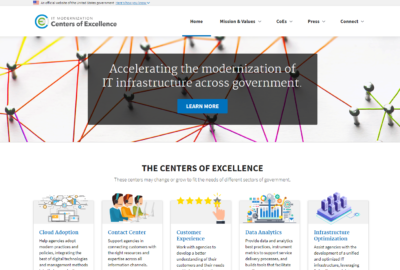
USDA says goodbye to contractor, GSA support for IT modernization Centers of Excellence
The Agriculture Department is taking over the development and implementation of its Centers of Excellence IT modernization initiatives after learning from...
Best listening experience is on Chrome, Firefox or Safari. Subscribe to Federal Drive’s daily audio interviews on Apple Podcasts or PodcastOne.
CLARIFICATION; GSA and USDA updated their statement about the future of their CoE partnership on Oct. 4.
The Agriculture Department is so confident in its ability to modernize everything from its call centers to its infrastructure to how it uses and analyzes data that it’s sending most of its contractor and government experts home.
After receiving less than a year of assistance, USDA made the surprising decision to end its long-term relationship with the General Services Administration’s IT Modernization Centers of Excellence and many of the 12 vendors, who GSA awarded six contracts to last October to support this effort, in three of the five areas.
On Oct. 4, GSA and USDA released an updated statement of its plans to work together going forward:
“USDA and GSA are proud to have completed their CoE workstreams of data analytics, infrastructure optimization, and cloud adoption ahead of schedule and on budget. Our work together will continue on implementing the ASK USDA Contact Center and the creation of ‘one front door’ for USDA customers. USDA and GSA’s partnership will further be highlighted by Secretary Perdue and Administrator Murphy at GSA’s IT Modernization event on Tuesday, Oct. 8,” the agencies said in a joint statement.
The spokesman confirmed that all Phase II CoE contracts will end on or before Oct. 15.
A GSA spokesman added the end of the partnership between the two agencies was scheduled to close at the end of fiscal 2019.
“The agreed upon plan is that USDA will take ownership at that time and sustain what has been delivered from GSA to USDA. It was a business decision to honor the original agreement. This has been a successful partnership,” said a USDA spokesman in a statement to Federal News Network. “Three of the five CoEs have been transitioned to USDA. USDA is currently transitioning the remaining 2 CoEs to the appropriate organization in USDA. We are implementing our contingency to have USDA sustain these COEs and institutionalize practices learned from the COEs.”
So while both agencies, and even the Office of Management and Budget, are all saying the right things publicly, there are few questions that arise.
First, if the schedule all along was for only one year of support from those 12 vendors, which GSA and USDA pulled out all the stops to develop the request for quotes, hold public industry days and aggressively announce the awards to, then why did four of the five contracts have options years?
- Customer experience digital support services—The performance period of this contract is from the effective date of this order and continuing for 12 months, with one option period of up to 12 additional months.
- Data analytics—The performance period of this contract is from the effective date of this order and continuing for 12 months, with one option period of up to 12 additional months.
- Business modernization office support—The total duration of this contract, including the exercise of any options under this clause, shall not exceed 2 years and 6 months.
- Infrastructure optimization and cloud adoption—The total duration of this contract, including the exercise of any options under this clause, shall not exceed 2 years and 6 months.
- Contact centers—No option period.
Industry sources say it’s almost unheard of for an agency not to pick up an option on a contract after just a year without a good reason, such as poor vendor performance or a major change in policy.
Since the Trump administration continues to support and expand the CoE concept and industry and government officials say USDA has been pleased with the support contractors provided, there must be another reason.
That leads us to the second question about the agency’s decision: multiple sources say USDA didn’t have the money to renew the contracts and that’s why they are taking over the CoEs.
The USDA spokesman didn’t directly respond to the question about funding, saying the decision to take over the CoEs is “not a matter of whether USDA has the money or not,” and there was no need to ask for more money in fiscal 2020.
“Due to where we are in our engagement with the CoEs, there has not been a business need to work with OMB or Congress to request additional funds for the COEs,” the spokesman said.
And the third question that arises over USDA’s decision focuses on the contractor support and how much progress could’ve been made in a year given a typical engagement usually needs a year to begin to see significant change. It’s clear there is still plenty of work around cloud adoption, data analytics and the other areas that may need contractor support in the near future. So by not picking up the options means USDA may have to go through another series of RFQs and awards that potentially would delay progress.
Related Stories
 Exclusive
Exclusive USDA, GSA accelerating Centers of Excellence efforts by releasing 6 RFQs
“Contractors are not happy, particularly small businesses, who feel they were left not winning any work,” said one industry sources, who requested anonymity in order to speak candidly about the program. “And large businesses thought they would make themselves invaluable and didn’t expect USDA to have them embedded with employee teams and do knowledge transfer. Once that happened, USDA is saying goodbye.”
The source said USDA was edging out contractors by spending every day and learning from them.
“You don’t see this very often, and it’s a model of not having to rely on contractors,” the source said. “It doesn’t say a lot about the contractors either and possibly puts fear in them.”
A GSA spokesman said USDA employees were detailed to the CoE teams to understand how to drive adoption.
“Training, outreach and community of practice development activities were also used to both ensure fiscal 2020 CoE self-sustainment and continued adoption,” the spokesman said. “Training activities were used to address individual mission area adoption of data analytics, increased agile adoption, cloud adoption alternatives, DevSecOps approach and other CoE related topics. Both data analytics and cloud CoEs have initiated communities of practice that will exist long after GSA CoEs leave USDA.”
Another industry source said the way USDA and GSA constructed the support contracts in a way that required the vendors and/or the agency to “sell” or “market” these services to other parts of the agency and that never happened.
“There wasn’t as much interest or clarity in that process,” the source said. “This was all a learning process for how to use these vehicles. I think it’s less about money and more about the clarity of the process in terms of how the agency could use the contracts with existing procurements and programs. That’s the biggest thing CoEs had to find out as they went through these efforts.”
The second source said despite these challenges, the CoEs were successful as a vehicle for moving faster and bringing innovation into the federal IT modernization process.
Latest Technology News
Since the beginning of the CoE effort, GSA and OMB wanted to disrupt the federal market.
Federal CIO Suzette Kent said in a statement to Federal News Network that OMB supports the concept that the CoEs are an accelerator to drive modernization and transformation across the government.
“We are thrilled at the success agencies and GSA have had with CoEs and look forward to continuing expanding the administration’s efforts for a 21st century government,” she said.
USDA and GSA say all five CoEs met their goals in almost all respects.
“The USDA and GSA CoE partnership met or exceeded all IT modernization implementation objectives,” said the GSA spokesman. “The CoE partnership measured its success in terms of adoption and its impact for both taxpayer citizen and the many stakeholders in the U.S. agricultural supply chain.”
USDA said the 5 COEs are providing value and have delivered the technology ahead of schedule and on budget: Below are some of the results USDA says it achieved over the last year:
Data Analytics modernization has enabled USDA to become more customer-focused, data driven and fact-based to provide results for the American People.
- Established enterprise data analytics services and developed 200+ dashboards to support USDA business decisions with wide adoption across all eight mission areas. Enabling data-driven decision making with high impact, customer facing programs.
- One dashboard is saving three-and-a-half weeks of report creation time per year.
- Avoided $10 million in duplicative infrastructure costs.
Cloud and Infrastructure COE – USDA is becoming more secure and efficient on behalf of the American taxpayers.
- Achieved closure of 26 data centers, on track to meet goal of 37 data center closures. Data center closures resulted in cost savings/cost avoidance of $42.3 million.
- Designed and launched a centralized USDA cloud office to facilitate cloud acquisitions, information resources and communities of practice to support cloud migrations
- USDA is now providing multi-cloud services and capability in a fully managed 24/7 environment, called AgCloud. Approved departmentwide solution for all agencies to leverage providing more secure, scalable and efficient cloud services.
Voice of the Customer COE – USDA is improving the overall customer experience through digital modernization and service delivery to its citizens.
- Launched customer feedback platform (Tell Sonny 2.0) with automated case management. Increased customer listening post from 12.5 million to 20 million people.
- Launched Farmers.gov to serve Farm Production and Conservation (FPAC) customers and employees through increasingly valuable interactions, both digital and in-person
Contact Center – USDA is improving the overall customer experience through digital modernization and service delivery to its citizens.
- Deployed the AskUSDA pilot contact center to establish industry capabilities, including enterprise customer relationship management, centralized knowledge management and performance management capability.
Customer Experience COE – USDA is improving the customer experience through our public facing customers.
- Designed and Launched Farmers.gov’s farm loan discovery tool and farm loan guides using human centered design principles. USDA farm loan approval rate in fiscal 2018 was 72%, which was up 3% from 2017. In 2018, there were 34,628 farmers with $5.5 billion in USDA loans.
- Launched a departmentwide website modernization effort and developed a USDA digital strategy website and roadmap.
- Launched the farm loans program view allowing customers to view their farm loan information, history and payments on their desktop computer or mobile phone.
- Developed the H-2A farmer facing portal.
- Developed the broadband reconnect program expanding broadband service to rural areas without sufficient broadband access.
GSA also says it’s using the lessons from the USDA experience with other agencies, including the Department of Housing and Urban Development, which is preparing to move into Phase II, and the Office of Personnel Management, which is in the discovery or Phase I of the CoE program.
“There were multiple lessons learned that will be applied at future CoE engagements. First, change management is a bigger challenge than technology complexity. Coordination within leadership is essential to ensure strategic alignment around the work and components,” the GSA spokesman said. “A second lesson learned was to use agency resources and leverage previously started IT modernization initiatives to drive increased interest and adoption. A key lesson learned was the importance to identify these capable in-house resources to leverage prior progress and also leverage their organizational understanding to drive increased adoption. The CoE also brings highly skilled IT resources that an agency would not normally have.”
Copyright © 2024 Federal News Network. All rights reserved. This website is not intended for users located within the European Economic Area.
Jason Miller is executive editor of Federal News Network and directs news coverage on the people, policy and programs of the federal government.
Follow @jmillerWFED






